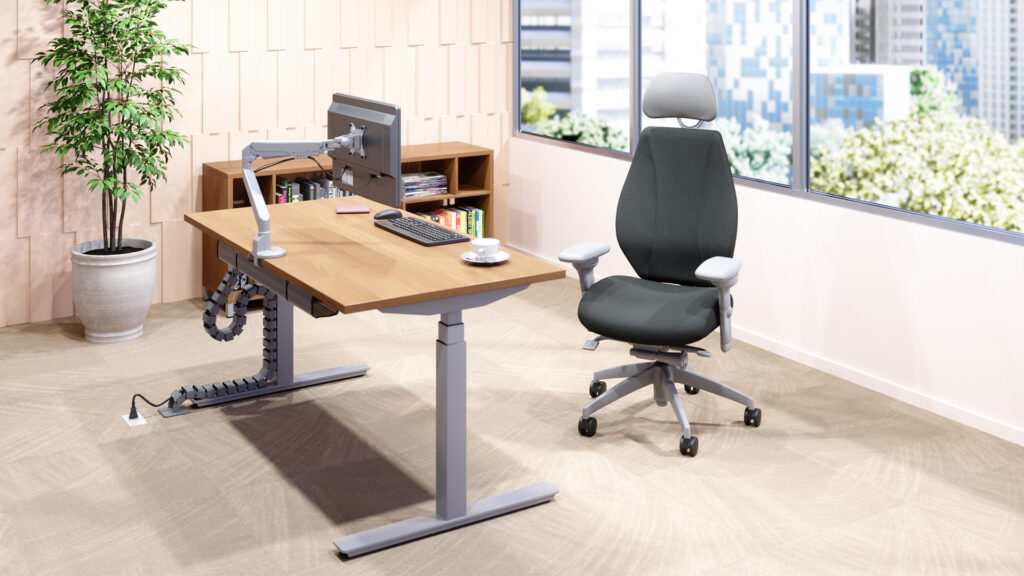20% off Demo Text
20% off Demo Text
When choosing ergonomic seating, it’s critical to ensure long-term comfort for your workforce, meet health & safety commitments and ensure sustainability standards are met. Investing in seating that will provide long-term value is key to keeping your workforce healthier and more productive.
How many injuries due to work-related musculoskeletal disorders did your company have in the last year? The last 3 years? What did they cost your organization? Have you ever tried quantifying the value of lost time due to sick days?
Sitting in the wrong chair in your workplace, day in and day out can be uncomfortable. But it doesn’t stop there. Awkward or static postures, excessive force, highly repetitive work, contact stress or static exertions are all contributing factors to work-related musculoskeletal disorders (MSD). MSDs account for 33% of all workplace injuries reported in the U.S., with an estimated economic burden between $45 and $54 billion annually in workers’ compensation costs, lost wages and lost productivity.
The fact is: workplace injury can be prevented. Providing office workers with a fully ergonomic seating solution and ergonomic training can decrease soft-tissue injury and have a significant impact on productivity. In addition to taking regular breaks from sitting, an adjustable chair that allows the user to have movement throughout the day – even in the seated position – which helps increase blood flow to the brain and to the body, keeping employees feeling refreshed and energized.
I’m looking for ergonomic seating for:
• The backrest should be the correct size for the length and width of the user’s back and should not cause localized pressure points.
• It should have a firm lumbar support to reposition the lumbar spine back into its natural curvature.
• It should have a lateral curve to reduce the amount of muscle activity required to maintain an upright posture.
The lumbar support should be height and depth adjustable.
• Armrests should be fully adjustable to allow the user to sit in a variety of postures while supporting their forearms in a manner that avoids lifting the shoulders (armrests too high) or leaning to the side/dropping the shoulders (armrests too low).
• The length and position of the armrests should allow users to properly support their forearms while sitting close enoughvto the work surface to perform their tasks while maintaining contact with the backrest.
• The armrests should provide adequate support for the forearm without affecting wrist movement or causing excessive pressure on the elbows.
• The inside distance between the armrests should allow the user to easily enter and exit the chair.
• The hips should comfortably fit between the armrests.
• Armrest caps should be wider than the user’s forearms
• The seat depth should be adjustable and should allow the user to sit fully against the backrest, allowing it to support the back properly.
• There should be approximately a three-finger width clearance between the back of the knees and the front of the seat so the legs can be positioned without compression at the back of the knee.
• The seat should be wide enough to support the full width of the buttocks. For users whose shoulders are less wide, armrest caps that can be adjusted inward may be necessary.
• The seat should have a waterfall front edge and have lateral curves to distribute the user’s weight away from the seat bones and should not put undue pressure on the base of the spine. The seat should not cause localized pressure points.
• The seat should tilt forward and backward to provide a variation in postures, should lock into multiple positions and have tilt tension control if the seat has a free float mode.
• The seat pan angles should not cause the user’s torso-to-thigh angle to be less than 90 degrees.
• The angle of the backrest should be independently adjustable from the seat.
• The user’s torso-to-thigh angle should be greater than 90 degrees.
• The seat height should be adjustable using a pneumatic cylinder. This allows the seat height to be easily adjusted and acts as a shock absorber when sitting down.
• The user should be able to sit with their feet comfortably on the floor or footrest without undue pressure on the underside of the thighs. The user’s torso-to-thigh angle should not be less than 90 degrees.
The base of the chair should have five legs and be the correct size for the size and type of the chair. If the base is too small it can cause a tipping hazard and if it is too large it can cause a tripping hazard.
• Casters should have the appropriate amount of friction between the wheels and the surface the chair is being used on so the chair is easy enough to move but does not move too easily which could cause the user to fall when getting in or out of the chair.
• Nylon casters are appropriate for carpeted floors.
• Urethane (rubberized) casters are necessary for hard surfaces such as wood or tile floors.
Our seating systems are modular and highly adjustable, designed to reduce the stresses caused by the seated posture and risk factors that could lead to work-related musculoskeletal disorders.
Recommended by 94% of ergonomists*, ergoCentric enables users to easily change their posture throughout the workday.
* Source: Manufacturer’s survey, conducted during ACE 2016 Conference.
